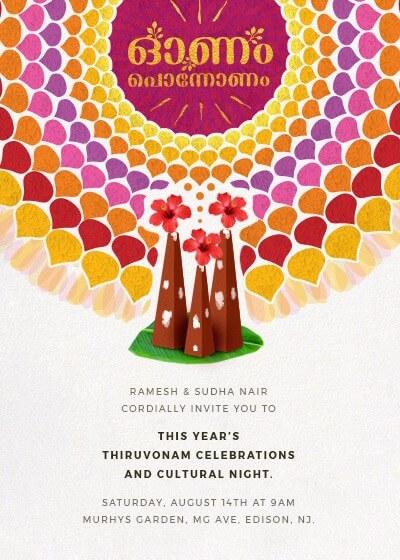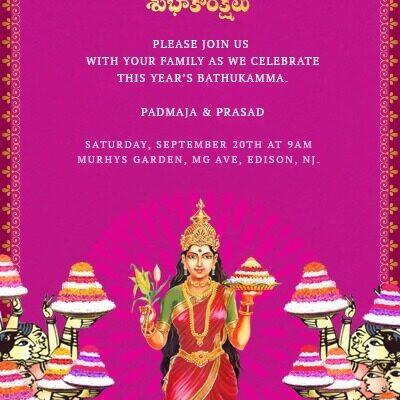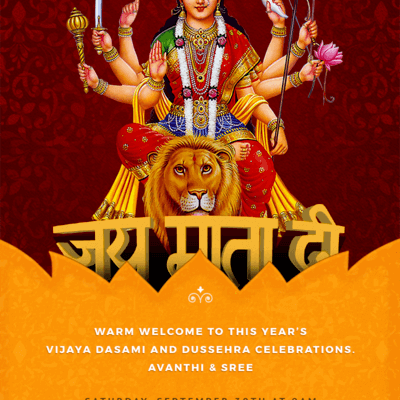
Onam is the harvest festival celebrated in the state of Kerala, in India. Coming towards the end of the Monsoon rains, it has always been a time to share the bountiful gifts that the earth provides the people of the state with friends and family. Celebrated over a number of days, varying from region to region, Onam traditionally spans a 10-day period of observances, beginning with “Atham” and ending on “Thiruvonam”, during which time gifts are exchanged, elaborate meals or “sadhyas” are prepared, large flower carpets have been artistically arranged, and people come together to share in the joy of the blessings that they have received and will receive in the coming year.
The Mythology
The festival of Onam celebrates the return of King Mahabali, a demon (Asura) king who was much loved by his subjects. Having defeated the Devas, or gods in fair battle, King Mahabali came to rule over the three worlds, and looked after them all very well. However, the Devas decided to avenge their defeat and set things right once again, and asked Lord Vishnu to help them regain their prestige. Lord Vishnu took on his fifth incarnation, turning into a diminutive Brahmin by the name of Vamana. Disguised as Vamana, a subject of one of the worlds, he approached King Mahabali and asked for a favor.
Praising the monarch by telling him that he had heard that no one who asks of a favour of the king was ever turned away empty-handed, King Mahabali asked him what he wanted. Vamana said that he wished to have an area of land that he would be able to traverse in three steps, nothing more. Amused by this request, King Mahabali granted him his request. However, it was then that Vamana revealed his true powers, and growing immense he took all of heaven in his first step, and all of the earth with his second step. Seeing this, King Mahabali realized that he was in the presence of Lord Vishnu himself and bowing in worship offered his own head for the third step to be taken. Touched by King Mahabali’s devotion, Lord Vishnu granted the king the permission to return to his kingdom and visit his subjects once a year.
Events to Observe/Participate In
In the state of Kerala, one of the spectacles that draws large crowds is the “Vallam kali” or ‘snake boat’ races that take place during Onam. These “snake boats” are large canoes that can hold up to 128 paddlers and be 120 feet in length, with teams of paddlers trying to shoot down a demarcated section of a lake at top speed. The Nehru Trophy Boat Race held in Punnamada Lake is one of the most famous of these races.
Closer to home, and with Malayalee/Keralite communities spread out all over the globe, you may be able to see “Pookalam” competitions where teams come together to create elaborate and colorful flower carpets in an effort to outdo one another. Traditional designs are generally round and have concentric patterns for traditionally these flower carpets were added to over several days. Nowadays, more modern designs are being presented. If you’re lucky, you may be able join in or create one of your own.
For those more interested in cuisine, the Onam “Sadhya” is a meal that is the crowning glory of festival celebrations. It can feature as many as twenty-six different items, all vegetarian, and in spite of its sumptuousness will leave you wanting more. Although the sadhya was traditionally prepared at home, now you can find special Malayalee restaurants that serve it, or even allow you to get a family pack sized meal that you can eat in the comfort of your home. However, for the true Onam Sadhya experience, see if you can get together with friends and dig into a veritable feast, or find a community centre or similar location that welcomes you to their Onam Celebrations. Trust us, you will be happy that you joined them. Wishing you a Happy Onam!
One of the most anticipated aspects of celebrating Onam is the “Onam Sadhya” or feast. A true sadhya includes twenty-six different dishes, beginning with the mildly flavoured to the richly spiced, before ending with the sweet touch of a couple of “pradhaman” dishes which will keep you sated for a while before you begin looking forward to the next Onam celebration. However, for those who are not accustomed to cooking with coconut or do not like the taste of coconut, either in the form of coconut oil, coconut milk or grated coconut, this vegetarian feast would not be as enjoyable as it was intended to be. On that note, there are more and more recipes in which people are substituting coconut as an ingredient for something else, so that everyone can enjoy the taste of the main ingredients. We share one such recipe for “avial” (pronounced “uh-VEE-ahl”) that does not use coconut, and we hope that you give it a try and enjoy it.
Onam “Avial” Without Coconut
Serves:
2 (As a side dish, this is best consumed with boiled rice, and curry of your choice, like ‘sambhar’)
Ingredients:
2 Cups – Mixture of chopped seasonal vegetables, such as Red/White Pumpkin, Carrots, and/or Moringa Drumstick.
1 ½ Cups – Curd
2 Nos – Green Chili (If you have issues with spice, you may substitute these chilis with half of a bell pepper)
2 Cloves – Garlic
¼-inch – Ginger
1 teaspoon – Chickpea Flour
1 teaspoon – Rice Flour
1 teaspoon – Red Chili Power (Optional. If you can find “Degi Mirch” it will give you a beautiful red color without the spiciness)
1 teaspoon – Vegetable Oil
¼-teaspoon – Turmeric Powder
¼-teaspoon – Ground Pepper
Salt to taste
A Few Curry Leaves
Steps:
- If you have not yet done so, cut the mixed vegetables into batons about an inch and a half in length, wash them and keep them aside.
- Prepare a coarsely ground paste of the 2 cloves of garlic, 2 green chillies and the ¼-inch piece of ginger.
- Boil 2 cups of water, and when it has come to a rolling boil, add the 2 cups of mixed vegetables, the paste of ginger, garlic and curd that you have just prepared, as well as the ¼-teaspoon of turmeric powder and salt. Cook the vegetables covered until they are al dente, for they will cook for a little longer in the following steps.
- Mix the 1 teaspoon of rice flour and 1 teaspoon of chickpea flour into the curd, making sure to mix well.
- Check to see if the vegetables are cooked al dente. If they are, then add this curd mixture to them, and reduce the heat to Low. The idea is to cook out the rawness of the rice flour and chickpea flour, and not necessarily to dry out the curd, which can burn if you are not careful.
- Once you see that the vegetable batons are mostly coated with the curd mixture, in about two or three minutes from when you added the curd mixture to them, add the 1 teaspoon of chili powder, ¼-teaspoon of ground pepper, and the curry leaves. Mix them into the vegetables so they are evenly infused.
- Lastly, turn off the heat and add 1 teaspoon of vegetable oil to help the curd mixture emulsify a little and to coat the vegetables and give them a nice glossy finish.
- Serve hot, along with some boiled rice and curry, like sambhar, or whatever curry you wish.
Additional Information:
- The mixed vegetables featured in this recipe are those that are harvested in time for the celebration of Onam, which is the harvest festival in the state of Kerala. If you are substituting vegetables due to lack of availability, please note, try and use hard, gourd vegetables that will not turn mushy when boiled. Potatoes are also not suggested because they will have a similar consistency when cooked, and if they fall apart while mixing in the curd mixture towards the end, then you will wind up with more of a mashed potato dish than an “Avial”. You can even use unripe plantains, keeping the thick green skin on them, cutting them into batons as you would the hard gourd vegetables. Worst case scenario, you can use two cups of mixed frozen vegetables that you find in most grocery stores and supermarkets. Please use a mixture that does not contain corn, however, only, carrots, peas and beans, and pay attention to adjust the cooking time accordingly.
- If you are substituting bell pepper for green chilli, you may want to add them either just before or at the same time as you add the curd mixture. This way, they will retain some crunch and not be too far cooked in relation to the other vegetables. Again, this will depend on the kinds of vegetables that you are going to use in the first place.
- The consistency of the final dish can have a little bit of a thick sauce, or if you can manage to not burn the curd mixture, to be mostly dry with an almost dry residue of curd that sticks to the vegetables. Because this is a side dish, the dryness of this dish will be compensated for by the other curry or curries that you will be eating it with.
- Have some fun with this recipe as you try it out and are more confident making it. See whatever other vegetables you can use based on what is readily available where you are. Most of all, enjoy and have fun with it. Happy Onam! Don’t forget to Inyte your friends and family to try this with you by going to Inytes.com and using our Onam Inytes.





